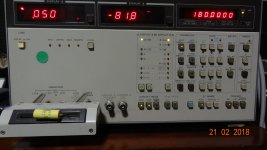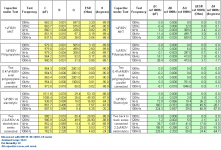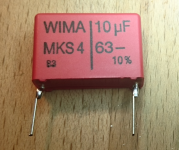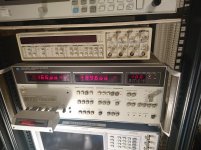90 degrees at 150Khz
Some measurement data.
I think another good point is the leakage current.
Work in progress.
George
Attachments
Some measurement data.
I think another good point is the leakage current.
Work in progress.
George
you show the same relative change between polar and film. Much worse degraded with polar. However, the values you choose -- 1 ufd -- is hardly the common value for coupling or fb cap. Much higher C are used and thus higher esr etc and worse phase. try a 100 or 1000 ufd cap range. Something likely to be used and heard, as I did.
Of course, then you have a problem comparing same value with type. But, still, I only use polar values that are typically used and listened to.
But, you show the trend.
Interesting though are the back-to-back polars. typically they have lower thd (lower volt drop across each) but the esr is in series so there was no improvement with phase.
THx-RNMarsh
Last edited:
Hi Richard, what is the value of your cap, just for reference?
Call me and I'll tell you.
Sorry, couldn't resist spoiling the High End Audio trade secrets: 4.7uF or so.
Leakage current of a polar cap.......
file:///C:/Users/Richard/Desktop/leakage-current-properties-of-modern-electrolytic-capacitors.pdf
THx-RNMarsh
file:///C:/Users/Richard/Desktop/leakage-current-properties-of-modern-electrolytic-capacitors.pdf
THx-RNMarsh
leakage current for an electrolytic cap is 5-20 uA per ufd -- new and at room temp.
and -- http://citeseerx.ist.psu.edu/viewdoc/download?doi=10.1.1.823.6133&rep=rep1&type=pdf
Cool stuff department --> Feeling charged up for... - Lawrence Livermore National Laboratory
-RNM
and -- http://citeseerx.ist.psu.edu/viewdoc/download?doi=10.1.1.823.6133&rep=rep1&type=pdf
Cool stuff department --> Feeling charged up for... - Lawrence Livermore National Laboratory
-RNM
Last edited:
There may be nothing wrong with your phone - as a phone. As a music reproducer it is dire: narrow bandwidth, high distortion, lossy compression, appalling transducers etc. I still cannot decide whether you are very very confused or just trolling.
Don't know what is inside, but, as I said, no complaints to it. The headphone amp is amazing and powerful. But, according to DF96, who know better than me how my smartphone sound, I'm both stupid and deaf...There should be plenty of phones out there now with ess9018 audio chains and headphone drivers based on re-purposed xDSL technology. They are all pretty good.
... This guy has reached my ignore list after he wrote: "I will assume RNM's confusion about Spice capacitor modelling was a momentary loss of concentration, not another fundamental error from someone who claims vast experience of audio."
I always appreciate humor when it is so elegant and respectful of others. This forum is full of gentlemen.
Last edited:
This is what a good film does to phase.
It is my patented design built by Rel-Cap. PPFX
REL-Invested $50K USD to have a custom cap making machine to do it.
It is only company who can make it. Co-patented by Bas Lim - owner of REl-Cap. I figured out what to do and how and Bas figured out how to make the machine work to make it to my design.
Its self resonance is much higher than typical PP caps. The esl and esr are lower. Up to 1/10th lower.
It is the esr + esl which causes the change in phase.
90 degrees at 150Khz
The cap you use in fb to ground, should be like this; Using PP film. But, its going to be huge for large values.
View attachment 664006
You tried to propagate the impression you were talking about quality at a level
that only your boutique super special manufacturer could produce.
We are amused, but not impressed, sorry.
This here is a WIMA MKS4 10u 63V. I have a bag full of them, about a pound.
The Wima 10u 16V in 11 * 7 * 15.7mm is about 1.5° worse.
Attachments
Last edited:
Hi Tournesol.Don't know what is inside, but, as I said, no complaints to it. The headphone amp is amazing and powerful. But, according to DF96, who know better than me how my smartphone sound, I'm both stupid and deaf...
I agree smartphones and tablets nowadays can output very high quality audio, plus of course the convenience and portability.....you ain't stupid nor deaf.
I'm thinking somebody else is confused, or is it trolling.....
Dan.
You tried to propagate the impression you were talking about quality at a level
that only your boutique super special manufacturer could produce.
We are amused, but not impressed, sorry.
This here is a WIMA MKS4 10u 63V. I have a bag full of them, about a pound.
The Wima 10u 16V in 11 * 7 * 15.7mm is about 1.5° worse.
Sorry you got that impression ?? ... I also said elsewhere any PP is almost as good. The large cap I used is 400vdc rated, film and foil. . I didnt show the brand name printed on it so as to not promote it.
WIMA is fine also. PP made by anyone is preferred for audio over polar types. PP is way way better than electrolytic is the point I made in comparison. Using my cap as example.... for a film-foil... not metalized... its self resonance is very high making the design useful to a higher freq. and very stable at high current. Nice for speaker cross-over, maybe.
To be clear -- the patent long ago expired (15 yrs?) and I do not get a penny for any sold. That cap I used from my spare parts bin is about twenty years old. They might still be made and sold because there is demand but I dont have the machine so I cant make them and have to buy them like everyone else. But, then i dont use them -- i go to dc-servo. 🙂
BTW -- Solen used to market to audiophiles a 100ufd PP - metallized, of course. It is the size of a soda can !
THx-RNMarsh
Last edited:
MKS4 is metalized Polyester.
Then it will be smaller than PP. Other parameters are better if you use PP.
All my comparisons are to electrolytic types against film types.
THx-RNMarsh
Last edited:
If you want real boutique "street cred" you can try the IPDiA 3D silicon caps:
3D Silicon Capacitors
3D Silicon Capacitors
and to drive our point home, here is a polycarbonate metalized film of 10ufd/50v ;
[self resonance approx 180KHz. 87 degrees at 100KHz]

Now compare that PC film to the electrolytics -- bi-polar and polar I showed only to 20Khz
10ufd bi-polar, again -- 50vdc Nichicon.

No contest. Any and all films win for Cfb and coupling over electrolytics. because Cfb is critical to amplifier performance.... film should be used. IMO.
In low noise amps where the R's are as low as practical, the Cfb would be very large and very large C value caps are really bad in many ways... high parasitics.
THx-RNMarsh
[self resonance approx 180KHz. 87 degrees at 100KHz]

Now compare that PC film to the electrolytics -- bi-polar and polar I showed only to 20Khz
10ufd bi-polar, again -- 50vdc Nichicon.

No contest. Any and all films win for Cfb and coupling over electrolytics. because Cfb is critical to amplifier performance.... film should be used. IMO.
In low noise amps where the R's are as low as practical, the Cfb would be very large and very large C value caps are really bad in many ways... high parasitics.
THx-RNMarsh
Last edited:
If you want real boutique "street cred" you can try the IPDiA 3D silicon caps:
3D Silicon Capacitors
That Does look interesting. Leakage at large values may be an issue and we dont know about THD. I should get some and also... the price and availability?
hey! audiophile marketing could say a 3-D cap makes for 3-D sound. ... better get on it and get rich. can't disappoint the infidels.
🙂
THx-Richy-Rich.
<3
Last edited:
I agree with that. But over here and with JC and others... why are we concerned about Those designs??
-Richard
IMO, the best way is to consider the amplifier as a black box, with input and output. Let the designer make a choice what he uses inside, what topology, which kind of components. The parameters, reliability, factors like these count. Let's forget designers popularizing stories and let's compare comparable. Anyone would tend to protect and emphasize his design strategy, though they are often totally different and regardless this fact may lead to similar commercial success. I agree with (JC e.g.) saying "works for me", it is OK, but it does not mean that specific design approach is the only and best way how to do it. In a discussion like this, when almost everyone sits in a different place of the world, the only comparable basis is measurement and even this should be done by an independent subject. The rest are claims that are not verifiable.
That Does look interesting. Leakage at large values may be an issue and we dont know about THD. I should get some and also... the price and availability?
hey! audiophile marketing could say a 3-D cap makes for 3-D sound. ... better get on it and get rich. can't disappoint the infidels.
🙂
THx-Richy-Rich.
<3
They have some of the line stocked at Mouser. Pretty expensive and not very large values available. The 3.3uF parts are low voltage and super expensive.
Murata / IPDiA Silicon Capacitors | Mouser
They compare to C0G ceramic in most of their PDFs, they seem to be targeting those and low value X7R caps for replacement. The leakage of the series that contains the 3.3uF caps claims as low as 1nA. Given the prices, values, and voltages available they probably aren't all that practical.
Also, while we're on electrolytics - has anyone measured a true solid polymer (ex. Panasonic SP-CAP, Oscon SVP), a hybrid polymer (ex. Panasonic ZA, Nichicon FPCAP), or the Niobium oxide caps? I am aware the leakage will be higher with the polymer caps.
Last edited:
- Status
- Not open for further replies.
- Home
- Member Areas
- The Lounge
- John Curl's Blowtorch preamplifier part III


